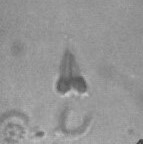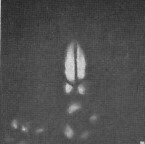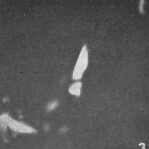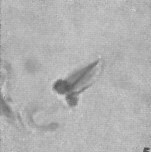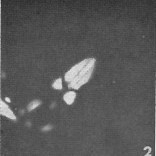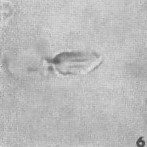Furcatolithus obtusus
Sphenolithus obtusus Bukry, 1971b
Questionable Furcatolith has a low hollow cylindrical proximal cycle and a long biconical compound apical spine made up of several longitudinal blades. The apical spine is a kite shape in the axial section with an obtuse proximal end angle.
In cross-polarised light, the compound apical spine with axial c-axis displays maximum birefringence at 45° and at 0° [the axial suture between the longitudinal blades is better seen at this orientation]. One side of the axial line of the furcatolith is dark at about 22° (oblique extinction).
All the other species of Furcatolithus have parallel extinction whereas Furcatolithus obtusus has an oblique extinction thus making the assignment to Furcatolithus questionable.
The apical spines of Furcatolithus obtusus have oblique extinction (extinction angle is about 22°) whereas the apical spine of Sphenolithus runus has parallel extinction (extinction angle is 0°) but the apical spine of Sphenolithus strigosus has an inclined extinction (extinction angle at 45°).
Furcatolithus obtusus differs from Sphenolithus strigosus Bown & Dunkley Jones, 2006 by having an apical spine with maximum birefringence at 45° and having a single cycled base [proximal cycle]. The latter has a double cycled base [proximal and lateral cycles], and its apical spine is extinct (dim) at 45° (inclined extinction).
Bown, P. R. & Dunkley Jones, T. 2006. New Paleogene calcareous nannofossil taxa from coastal Tanzania: Tanzania Drilling Project Sites 11 to 14. Journal of Nannoplankton Research 28(1): 17-34.
Bukry, D. 1971b. Cenozoic calcareous nannofossils from the Pacific Ocean. - San Diego Society of Natural History Transactions 16: 303-327.
Howe, R., 2021. Ultrastructure and taxonomy of the family Sphenolithaceae. Journal of Nannoplankton Research 39(1), 29-75.
